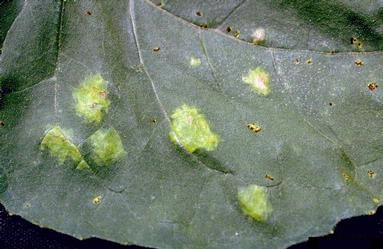Albugo Macalpineana on:
[Wikipedia]
[Google]
[Amazon]
''Albugo'' is a genus of plant-parasitic oomycetes. Those are not true fungi ( Eumycota), although many discussions of this organism still treat it as a fungus. The taxonomy of this genus is incomplete, but several species are
(PDF), RPD No. 960, Univ. of Illinois Extension, uiuc.edu, September 1990.
plant pathogens
Plant pathology (also phytopathology) is the scientific study of diseases in plants caused by pathogens (infectious organisms) and environmental conditions (physiological factors). Organisms that cause infectious disease include fungi, oomyc ...
. ''Albugo'' is one of three genera currently described in the family Albuginaceae, the taxonomy of many species is still in flux.
This organism causes white rust or white blister diseases in above-ground plant tissues. While these organisms affect many types of plants, the destructive aspect of infection is limited to a few agricultural crops, including: beets (garden and sugar), Brussels sprouts, cabbage
Cabbage, comprising several cultivars of ''Brassica oleracea'', is a leafy green, red (purple), or white (pale green) biennial plant grown as an annual vegetable crop for its dense-leaved heads. It is descended from the wild cabbage ( ''B.&nb ...
s, Chinese cabbage, cauliflower
Cauliflower is one of several vegetables in the species ''Brassica oleracea'' in the genus ''Brassica'', which is in the Brassicaceae (or mustard) family. It is an annual plant that reproduces by seed. Typically, only the head is eaten – the ...
, collards, garden cress
Cress (''Lepidium sativum''), sometimes referred to as garden cress (or curly cress) to distinguish it from Cress (disambiguation), similar plants also referred to as cress (from old Germanic ''cresso'' which means sharp, spicy), is a rather fas ...
, kale
Kale (), or leaf cabbage, belongs to a group of cabbage (''Brassica oleracea'') cultivars grown for their edible leaves, although some are used as ornamentals. Kale plants have green or purple leaves, and the central leaves do not form a head ...
, lettuce, mustards, parsnip, radish, horseradish, rapeseed, salsify (black or white), spinach
Spinach (''Spinacia oleracea'') is a leafy green flowering plant native to central and western Asia. It is of the order Caryophyllales, family Amaranthaceae, subfamily Chenopodioideae. Its leaves are a common edible vegetable consumed either f ...
, sweet potato
The sweet potato or sweetpotato (''Ipomoea batatas'') is a dicotyledonous plant that belongs to the Convolvulus, bindweed or morning glory family (biology), family, Convolvulaceae. Its large, starchy, sweet-tasting tuberous roots are used as a r ...
es, turnips, watercress, and perhaps water-spinach
''Ipomoea aquatica'', widely known as water spinach, is a semi- aquatic, tropical plant grown as a vegetable for its tender shoots. ''I. aquatica'' is generally believed to have been first domesticated in Southeast Asia. It is widely cultiv ...
.
Summary
White rust plant diseases caused by ''Albugo'' fungal-like pathogens should not be confused with white pine blister rust, Chrysanthemum white rust or anyfungal rust
Rusts are plant diseases caused by pathogenic fungi of the order Pucciniales (previously known as Uredinales).
An estimated 168 rust genera and approximately 7,000 species, more than half of which belong to the genus '' Puccinia'', are currently ...
s, all of which are also plant diseases but have completely different symptoms and causal pathogens. Symptoms of white rust caused by ''Albugo'' typically include yellow lesions on the upper leaf surface and white pustules on the underside of the leaf. The pathogen is spread by wind, water, and insects. Management includes use of resistant cultivars, proper irrigation practices, crop rotation, sanitation, and chemical control. White rust is an important economic disease, causing severe crop losses if not controlled.
Hosts and symptoms
White rust pathogens create chlorotic (yellowed) lesions and sometimes galls on the upper leaf surface and there are corresponding white blister-like dispersal pustules of sporangia on the underside of the leaf. Species of the Albuginaceae deform the branches and flower parts of many host species. Host species include most if not all plants in the family Brassicaceae, common agricultural weeds, and those specified below."White Rusts of Vegetables"(PDF), RPD No. 960, Univ. of Illinois Extension, uiuc.edu, September 1990.

Disease cycle
White rust is anobligate parasite
An obligate parasite or holoparasite is a parasitic organism that cannot complete its life-cycle without exploiting a suitable host. If an obligate parasite cannot obtain a host it will fail to reproduce. This is opposed to a facultative parasite, ...
. This means it needs a living host to grow and reproduce. The Albuginaceae reproduce by producing both sexual spores (called oospores) and asexual spores (called sporangia) in a many-stage (polycyclic) disease cycle.
The thick-walled oospores are the main overwintering structures, but the mycelium can also survive in conditions where all the plant material is not destroyed during the winter. In the spring the oospores germinate and produce sporangia on short stalks called sporangiophore
{{Short pages monitor